
|   |

|   |
 e-mail: leelakaverivenkat@gmail.com Kathak dance evolving out of a cultural process Photos courtesy: Navina Jafa & Jayashree Acharya September 28, 2018 A serious scholar whose theories are based on information gathered by delving into sources and doing field research, Dr.Navina Jafa spoke on her perspective of how Kathak evolved as a dance form in a programme Safarnama comprising a talk followed by a short dance presentation at the Alliance Francaise, Delhi. The nodal point of what she was saying was that rather than looking at the dance history as a linear development, one should look at it as a cultural process in circularity, evolving out of the eco system in which art lives - its various aspects comprising performance ingredients from different groups of people, who for various reasons, political, climatic, social, migrated and settled in different parts plying their respective trade. The Bahi Kathas of Gaya, Ayodhya, Prayag, the Kirtaniyas, the Dhadis, the Bards all were part of narrative traditions -influenced by both cultural interactions during travel, and art practices dictated by law of demand and supply. As the speaker pointed out, why would a Dutch scholar years ago write about 'Ayodhya Mahatmya' if constant travel had not caused churnings due to contacts, bringing about changes even in the demography of a region. Her own Guru Birju Maharaj's family, due to compulsions went from Lucknow to Rampur. Since reference to Kathak as a full fledged dance form is not found in any early literature, Navina went deeper into Court Records (many of which got destroyed- sometimes deliberately, in 1857), Municipal and government records, archives, paintings and sculpture - all grist for Navina's studies. After managing to get, through several channels of red tape, permission to look through some pages of Raigarh Court's Nartan Sarvasya, (kept under lock and key and guarded by a huge dog who remained right at the spot where Navina was doing her research, ready to pounce on her if she made the slightest sign suggesting her noting down what she had read on a piece of paper - forcing her to depend only on her memory) where she found full fledged 'bandishes' of a systematised dance art - though not in the name of Kathak. She also looked at Bikaner Library records, mention of paramparas of Churu district. She studied cross cultural influences of traditions -like 16th and 17th century Islamic art and culture, and the story telling art of Harikathas, Pandvanis - all part of the total cultural scenario. The word Kathakas referred to a community of people rather than to a dance form. Words like Naach, Nrityas, Nartan as validation of lineages were used and it was only in 1925, according to Navina, that during the fourth or fifth Bhatkhande Music Conference, that dance by Lucknow's Shambhu Maharaj was mentioned in the invitation as Kathak. 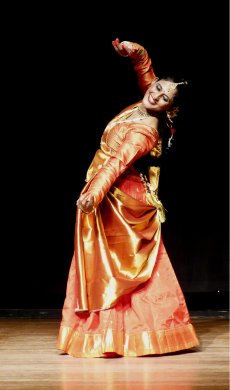 Navina Jafa In Navina's talk, pointing out to some typical aspects of Kathak like the straight stance, the way the hands are used, the footwork and the use of ghungroos, some very interesting references came from very ancient non Indian forms. The dupatta added to the costume (Islamic influence) brought in the third dimension, to what was a two dimensional straight body of the Kathak technique, according to Navina. As early as 520 BC, the Greek Yavanas (old Persian word Yauna), young boys in the military (of Darius the Great) were trained for dance, performing with ankle bells called Mazari (mentioned by Allah Daad). The Bachas of Central Asia and North West Asia including the Indian subcontinent, Afghanistan and Kashmir wore ankle bells while performing clad in a Jaaman. We all know about the Flamenco with its erect stance and foot tapping technique so close to Kathak. The Uzbek dances, the dance costumes in paintings, the 19th century paintings, the art of hand gestures of Cheironomia (Greek) which Aeschycles mentioned, were all referred to, showing how aspects of Kathak could have been influenced by non Indian art practices too. The talk touched on aspects of how dance aesthetics was shaped by many factors. While the brief talk was excellent in explaining the speaker's point of view in just half an hour, the short dance presentation, (coming for Navina after being away from the performance side of Kathak for over twenty years) had to be seen as a very brave attempt. The brief teental thaat, uthan, tora and tukras was followed by abhinaya with its accent on how sahitya (not always traditional) could be woven into the Kathak technical format - very crucial aspect for the performance scene today with abhinaya so minimal as to be almost non existent. One knows that the dancer was learning abhinaya from Jamuna Krishnan and this could have inspired her taking 13th century Vidyapati's poetry (on which Jamuna has done a lot of research) as the base sahitya (though the printed note distributed makes no mention of this against Jamuna Krishnan's name at the bottom), describing a dialogue between the Mugdha Nayika and Madana (Kamadeva), Kathana vedana mohi dese Madana, including an insertion of a shloka from Mukundmala - originally selected by Bharatanatyam dancer Jamuna Krishnan who also set the music. The nayika confronts Madana thwarting her with his flowered darts that as her entire being is already suffused with Krishna consciousness, there is little that Kamadev could do. And besides he has already had his lesson getting burnt once by Shiva. This work was reworked by Navina's Guru Pt Birju Maharaj, keeping Kathak considerations in mind, with the dancer herself again reinterpreting the work. An additional poem describing Kamadev, in Braj written by Himanshu Srivastava was also included and given elaborate treatment in the dance. What was really praiseworthy was the dancer's intelligent creative approach with words in the poetry used rhythmically in a Kavit mode in places with gat bhav spun into the interpretation - thus making the sahitya a natural part of the dance - which did not, importantly have to depend on any virtuosity of exhibitionistic rhythm or chakkars. Sentences were also interpreted through sancharis. What Navina has to work on however, is on acquiring impeccable rhythmic control and more importantly in bringing subtlety into now very broad gestures like a shake of the head or an uplifted hand or a glance of the eye. With her capacity for detail, she is bound to evolve. And the live music, (expensive for Kathak dancers today) muted and melodious (though the small space has no proper arrangements for monitors enabling the performer to hear the music) was much appreciated. And good to show how Kathak does not need overdone 'peir ka kaam' or chakkars ad nauseum! An In Memoriam for Parveen Gangani's unfinished story 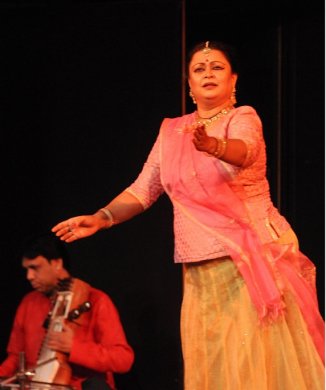 Jayashree Acharya Very different in tone was the other significant Kathak event Yaadon ke Phool (Flowers of Remembrance) at the Stein auditorium organised by Jayashree Acharya, in memory of Parveen Gangani, who in June passed away in Kuala Lumpur, a tragically premature death, drowning in a swimming pool on board the ship on the very first day of a cruise. Born to the famed Jaipur Gangani Parampara, Parveen was very unusually, sent by his Guru (his brother Manish Gangani) to Pt Birju Maharaj for training in the Lucknow gharana too, and Birju Maharaj who graced the occasion spoke generously of how Parveen had been like a member of his family, his affable nature making him popular with every body. Shovana Narayan too through a video paid tribute to his human and artistic qualities as did Aditi Mangaldas speaking of his role in Drishtikon, in its performances. Parveen Gangani also worked with Bharatiya Kala Kendra and after returning from a stint in Europe, came back to India in 2004 and set up his own Kathak Disha Academy of Dance and Music. Parveen taught dance in Moscow and Kuala Lumpur on ICCR postings. His training in both the Jaipur and Lucknow gharanas, while responded to at that time, by the Jaipur khandan with mixed feelings, his persona certainly evoked very shared feelings of sadness by his premature end in both gharanas, as proved by the performers from both schools. The evening performance where each dancer was given just a 20-25 minute slot was efficiently planned and began with two students of Jayashree Acharya of the Lucknow gharana, providing a well-combined neat opening duet with the Shiva Stuti Bho shambho Swayambho. Jayashree Acharya's own solo presenting shuddha nritta in teental, with her training under Reba Vidyarthi and Pt Birju Maharaj saw her as a dancer who moves very smoothly, the fluid movements of her pure dance followed by abhinaya done to a Thumri composition in Darbari, Khelo priya sanga hori, portraying infinite love for Krishna where everything becomes a reflection of his being. And the dancer's involved rendition brought out the required mood. 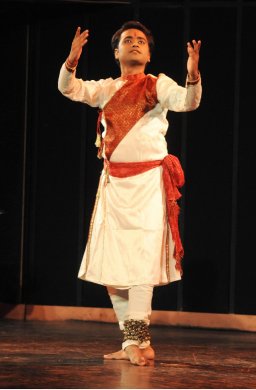 Mukesh Gangani I was deeply impressed by Parveen Gangani's young son Mukesh Gangani, who had accompanied his father as a participant in the Moscow festival. His scrupulously clean ang and excellent stance showed impeccable control, the most acrobatic bandishes with knee stretches and squats, at high speed, executed with smiling ease, without a hint of effort or smudging of the dance line. And his smiling countenance adds to the pleasing stage presence. The tabla player was his brother Abhishek. Presenting only Jaipur gharana bandishes , the Kavit on Krishna in misra jati and moving between tisra and misra, the dancer never faltered. His immaculate footwork and chakkars showed really painstaking 'tayyari'. With a fine singer in Duleeb Parihar, his interpretation of a line like "Gopiya name Radha bani" showed a feel for abhinaya which needs to be developed through the right kind of training. I hope he gets it for this will make him a complete dancer. 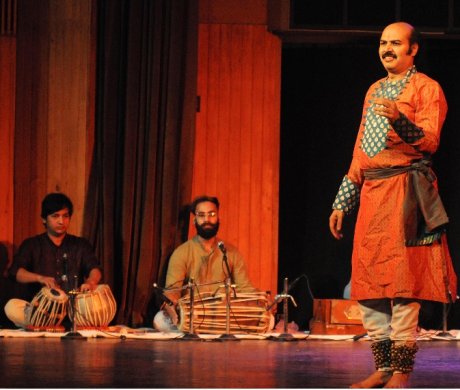 Devanand Parihar Devanand Parihar, a disciple of Jaipur gharana's Rajendra Gangani with Ashish Kumar providing vocal support along with an excellent young tablist Suraj Nirvan, began with "Omkar bindu samyuktam" followed by a fine tabla ka kayada, and after that a very brief interpretation of sahitya for which the song, Ud jayega hamsa akela, was very melodiously sung. 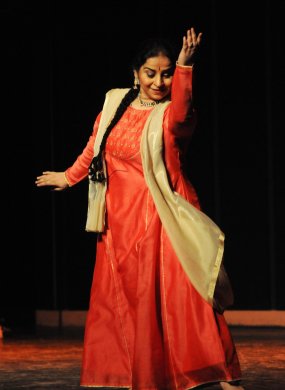 Mamta Maharaj Birju Maharaj's daughter Mamta Maharaj with vocal support from Jai Dadheech and percussion accompaniment by Pramshur Chaturvedi presented a very involved and well elaborated Bindadin composition interpretation, Aise Ram hai to dukh haran in Kauns. Whether it was Krishna as saviour in Draupadi vastraharan (Kheencch Draupadi lai Dushasan cheer lagyo haran) or Govardhan lila the narratives had expressional elegance which never degenerated into loud theatre. I missed the last performer, Pt Birju Maharaj's son Deepak Maharaj, due to unavoidable reasons. One hopes and prays that Parveen's unfinished story will have its continuation in the success of the next generation.  Writing on the dance scene for the last forty years, Leela Venkataraman's incisive comments on performances of all dance forms, participation in dance discussions both in India and abroad, and as a regular contributor to Hindu Friday Review, journals like Sruti and Nartanam, makes her voice respected for its balanced critiquing. She is the author of several books like Indian Classical dance: Tradition in Transition, Classical Dance in India and Indian Classical dance: The Renaissance and Beyond. Post your comments Please provide your name and email id when you use the Anonymous profile in the blog to post a comment. All appropriate comments posted with name & email id in the blog will also be featured in the site. |